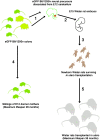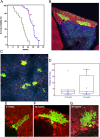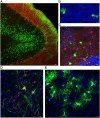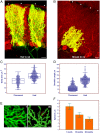Lifespan of neurons is uncoupled from organismal lifespan
- PMID: 23440189
- PMCID: PMC3600460
- DOI: 10.1073/pnas.1217505110
Lifespan of neurons is uncoupled from organismal lifespan
Abstract
Neurons in mammals do not undergo replicative aging, and, in absence of pathologic conditions, their lifespan is limited only by the maximum lifespan of the organism. Whether neuronal lifespan is determined by the strain-specific lifetime or can be extended beyond this limit is unknown. Here, we transplanted embryonic mouse cerebellar precursors into the developing brain of the longer-living Wistar rats. The donor cells integrated into the rat cerebellum developing into mature neurons while retaining mouse-specific morphometric traits. In their new environment, the grafted mouse neurons did not die at or before the maximum lifespan of their strain of origin but survived as long as 36 mo, doubling the average lifespan of the donor mice. Thus, the lifespan of neurons is not limited by the maximum lifespan of the donor organism, but continues when transplanted in a longer-living host.
Conflict of interest statement
The authors declare no conflict of interest.
Figures




Similar articles
-
Mature astrocytes transform into transitional radial glia within adult mouse neocortex that supports directed migration of transplanted immature neurons.Exp Neurol. 1999 May;157(1):43-57. doi: 10.1006/exnr.1999.6982. Exp Neurol. 1999. PMID: 10222107
-
Extracerebellar progenitors grafted to the neurogenic milieu of the postnatal rat cerebellum adapt to the host environment but fail to acquire cerebellar identities.Eur J Neurosci. 2010 Apr;31(8):1340-51. doi: 10.1111/j.1460-9568.2010.07167.x. Epub 2010 Apr 9. Eur J Neurosci. 2010. PMID: 20384777
-
Absence of replicative senescence in cultured cells from the short-lived killifish Nothobranchius furzeri.Exp Gerontol. 2013 Jan;48(1):17-28. doi: 10.1016/j.exger.2012.02.012. Epub 2012 Mar 13. Exp Gerontol. 2013. PMID: 22445733
-
Does aging need its own program, or is the program of development quite sufficient for it? Stationary cell cultures as a tool to search for anti-aging factors.Curr Aging Sci. 2013 Feb;6(1):14-20. doi: 10.2174/18746098112059990009. Curr Aging Sci. 2013. PMID: 23387885 Review.
-
Telomere control of replicative lifespan.Exp Gerontol. 1997 Jul-Oct;32(4-5):375-82. doi: 10.1016/s0531-5565(96)00164-7. Exp Gerontol. 1997. PMID: 9315442 Review.
Cited by
-
Gene expression signatures of human cell and tissue longevity.NPJ Aging Mech Dis. 2016 Jul 7;2:16014. doi: 10.1038/npjamd.2016.14. eCollection 2016. NPJ Aging Mech Dis. 2016. PMID: 28721269 Free PMC article.
-
DNA Methylation Signature of Aging: Potential Impact on the Pathogenesis of Parkinson's Disease.J Parkinsons Dis. 2023;13(2):145-164. doi: 10.3233/JPD-223517. J Parkinsons Dis. 2023. PMID: 36710687 Free PMC article. Review.
-
Neuronal Cell Death Mechanisms in Major Neurodegenerative Diseases.Int J Mol Sci. 2018 Oct 9;19(10):3082. doi: 10.3390/ijms19103082. Int J Mol Sci. 2018. PMID: 30304824 Free PMC article. Review.
-
Single-Cell Transcriptional Response of the Placenta to the Ablation of Caveolin-1: Insights into the Adaptive Regulation of Brain-Placental Axis in Mice.Cells. 2024 Jan 24;13(3):215. doi: 10.3390/cells13030215. Cells. 2024. PMID: 38334607 Free PMC article.
-
Role of primary aging hallmarks in Alzheimer´s disease.Theranostics. 2023 Jan 1;13(1):197-230. doi: 10.7150/thno.79535. eCollection 2023. Theranostics. 2023. PMID: 36593969 Free PMC article. Review.

